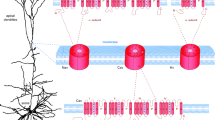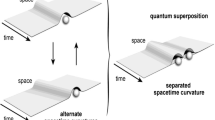Abstract
In the paper titled “Quantum Measurement, Consciousness and the Soul: A New, Alternative Position” by Werbos, 2018a, he concludes about the problem of quantum measurement: “All of this physics does not tell us much about consciousness or the soul…” and he suggests that the answers may be found in other areas of science, like neuroscience and neural networks for example. Let us begin by extending these areas to cognitive science, systems neuroscience, non-linear system dynamics, mathematics, and classical and quantum physics. I will take a stand that supports the view that some form of quantum theory may facilitate our understanding of consciousness, mind, soul, and spiritual values-based decision-making. The most relevant authors and theories that I will briefly explore are Henry P. Stapp’s Quantum Interactive Dualism (QID) (Stapp, 2009a; Stapp, 2006) and Walter Freeman’s and Robert Kozma’s Cinematic Theory of Cortical Phase Transitions (Kozma & Freeman, 2016), where both theories, in different ways, serve as a foundation for the understanding of how the brain creates knowledge and meaning for intentional action and value-based decision-making. Finally, it is proposed that Stapp’s contribution together with Freeman’s and Kozma’s views in conjunction with the work of Giuseppe Vitiello can be regarded as sound and complementary platforms to build upon the big picture of consciousness, together with a platform of noospheres, similar yet different than the ones described by Teilhard de Chardin (de Chardin, 1966).
Similar content being viewed by others
Explore related subjects
Discover the latest articles, news and stories from top researchers in related subjects.Notes
The symbol ~ is used in the manner of J. A. Scott Kelso and David A. EngstrØm (Scott Kelso and Engstrøm, 2006)
Declaration of Independence of The United States of America, 1776.
J. J. Joshua Davis.
References
Atmanspacher, H. (2018). Walter Freeman - I did it my way. In H. Liljenström (Ed.), Journal of Consciousness Studies (pp. 39–44, vol. 25). Exeter: Imprint Academic.
Baars, B. J. (2003). The double life of B.F. Skinner: inner conflict, dissociation and the scientific taboo against consciousness ," in Journal of Consciousness Studies.: Imprint Academic, vol. 10, pp. 5–25.
Baars, B. J., & Edelman, D. B. (2012). Consciousness, biology and quantum hypotheses. Physics of Life Reviews, 9(3), 285–294.
Baars, B. J., & Gage, N. M. (2010). Cognition, brain, and consciousness: introduction to cognitive neuroscience (2nd ed.). Amsterdam: Elsevier.
Capra, F., & Luisi, P. L. (2014). The systems view of life: a unifying vision. Cambridge: Cambridge University Press.
Childre, D., Martin, H., Rozman, D., & McCraty, R. (2016). Heart intelligence: connecting with the intuitive guidance of the heart. Cardiff: Waterfront Digital Press.
Davis, J. J. J. (2009). The brain of Melchizedek: a cognitive neuroscience approach to spirituality (thesis, master of science). Dunedin: University of Otago.
Davis, J. J. & Kozma, R. (2013). "Creation of knowledge & meaning manifested via cortical singularities in cognition: Towards a methodology to understand intentionality and critical behavior in neural correlates of awareness," in 2013 IEEE Symposium on Computational Intelligence, Cognitive Algorithms, Mind, and Brain (CCMB), Singapore, pp. 15–22.
Davis, J. J. J. & Walling, B. (2018). The biophysics of values & social harmony: the complementarities of energy~mind~spirit a triune approach. Journal of Consciousness Exploration & Research, vol. 9, no. 2, pp. 77-112, Also published in SGJ 9(4) 2018 https://www.scigod.com/index.php/sgj/article/view/624. Accessed 15 May 2019.
Davis, J. J. J., Kozma, R. & Freeman, W. J. (2013). Neurophysiological evidence of the cognitive cycle and the emergence of awareness. In 2013 iCAST & UMEDIA, Aizu-Wakamatsu, pp. 149–157.
Davis, J. J. J., Gillett, G., & Kozma, R. (2015). Revisiting Brentano on consciousness: striking correlations with electrocorticogram findings about the action-perception cycle and the emergence of knowledge and meaning. Mind and Matter, 13(1), 45–69.
de Chardin, P. T. (1966). The vision of the past. New York: Harper & Row.
Dehaene, S., & Changeux, J.-P. (2011). Experimental and theoretical approaches to conscious processing. Neuron, 70(2), 200–227.
Freeman, W. J. (2014). Book review: Karl H Pribram (2013) The form within: my point of view. Journal of Integrative Neuroscience, 13(2), 429–433.
Freeman, W. J., & Vitiello, G. (2006). Nonlinear brain dynamics as macroscopic manifestation of underlying many-body field dynamics. Physics of Life Reviews, 3(2), 93–118.
Freeman, W. J. & Vitiello, G. (2016a). ResearchGate. [Online]. https://www.researchgate.net/publication/290428630_Matter_and_Mind_are_Entangled_in_EEG_Amplitude_Modulation_and_its_Double_Preprint_Univty_California_at_Berkeley_CA_USA. Accessed 15 May 2019.
Freeman, W. J., & Vitiello, G. (2016b). Matter and mind are entangled in two streams of images guiding behavior and informing the subject through awareness. Mind and Matter, 14(1), 7–24.
Freud, S. (1990). The ego and the id (the standard edition of the complete psychological works of Sigmund Freud). In James Strachey. New York: W. W. Norton & Company.
Freud, S. (2010). Civilization and its discontents. In James Strachey. New York: W. W. Norton & Company.
Gillett, G. & Davis, J. J. J. (2015) A brief introduction to the brain and paradigm of Melchizedek, Journal of Consciousness Exploration & Research, vol. 6, no. 5, pp. 267–272. http://www.jcer.com/index.php/jcj/article/view/445. Accessed 15 May 2019.
Hurtak, J. J. (1977). The book of knowledge: the keys of Enoch. Los Gatos: The academy for Futuescience.
Jung, C. G. (2006). The undiscovered self: the dilemma of the individual in modern society. Iowa City: Berkley.
Jung, C. G. (2012). The red book: a reader’s edition. New York: W. W. Norton & Company.
Kozma, R., & Davis, J. J. J. (2018). Why do phase transitions matter in minds? Journal of Consciousness Studies, 25(1–2), 131–150.
Kozma, R. & Freeman, W. J. (2016). Cognitive phase transitions in the cerebral cortex - enhancing the neuron doctrine by modeling neural fields, 1st ed., Kacprzyk and Janusz, Eds. Switzerland: Springer International Publishing, vol. 39.
Lehmann, D., et al. (2001). Brain sources of EEG gamma frequency during volitionally meditation-induced, altered states of consciousness, and experience of the self. Psychiatry Research: Neuroimaging Section, 108(2), 111–121.
Maslow, A. H. (1964). Religions, values, and peak experiences.: Penguin Books
Michel, C. M. & Koenig, T. (2017). "EEG microstates as a tool for studying the temporal dynamics of whole-brain neuronal networks: a review," NeuroImage, In Press, Corrected Proof.
Piaget, J. (2001). The psychology of intelligence. London: Routledge.
Pribram, K. H. (2013). The form within: my point of view. Westport: Prospecta Press.
Pribram, K. H. & Carlton, E. H. (1986), "Holonomic brain theory in imaging and object perception," Acta Psychologica, vol. 63, no. 2, pp. 175–210. http://www.karlpribram.com/review-and-theory-chapters/ (T-164). Accessed 15 May 2019.
Scott Kelso, J. A., & Engstrøm, D. A. (2006). The complementary nature. Cambridge: MIT Press.
Sheldrake, R. (1988). The presence of the past – the morphic resonance and the habits of nature. London, UK: Collins.
Stapp, H. P. (1982). Mind, matter, and quantum mechanics. Foundations of Physics, vol. 12, no. 4.
Stapp, H. P. (1997). Nonlocal character of quantum theory. American Journal of Physics, 65(4), 300–304.
Stapp, H. P. (2006). Henry Stapp on quantum mechanics, spirit, mind, and morality - quantum interactive dualism: an alternative to materialsm. Zygon: Journal of Religion & Science, vol. 41, no. 3.
Stapp, H. P. (2007). Mindful universe - quantum mechanics and the participating observer. Berlin: Springer.
Stapp, H. P. (2009a). Mind matter and quantum mechanics. Berlin: Springer-Verlag.
Stapp, H. P. (2009b). Pragmatic approach to consciousness. In K. H. Pribram (Ed.), Brain and Values: Is a Biological Science of Values Possible. New York: Psychology Press.
Urantia Foundation. (1955). The Urantia Book. Chicago: Urantia Foundation.
Vitiello, G. (2018). The brain and its mindful double. in Journal of Consciousness Studies, Hans Liljenström, Ed. Exeter, UK: Imprint Academic, vol. 25, pp. 151–76.
Werbos, P., J. (2015). Links between consciousness and the physics of time. Problems of Nonlinear Analysis in Engineering Systems, 21(1(43)), 1–16 https://www.google.co.nz/url?sa=t&rct=j&q=&esrc=s&source=web&cd=15&cad=rja&uact=8&ved=0ahUKEwizje2GwNXVAhUKw7wKHYZuCOU4ChAWCDgwBA&url=http%3A%2F%2Fkpfu.ru%2Fportal%2Fdocs%2FF2021541261%2FPNAES.N.1_43_.v.21.2015.pdf&usg=AFQjCNEElMWQndmSWFcxQHJ4fj8BRUl2Ag. Accessed 15 May 2019
Werbos, P. J. (2017). Unification of objective realism and spiritual development. in Science and Scientist 2017, Kathmandu, pp. 87–92. http://scsiscs.org/conference/index.php/scienceandscientist/2017/paper/view/166. Accessed 15 May 2019.
Werbos, P. J. (2018a). Quantum measurement, consciousness and the soul: a new, alternative position. USA: In Press.
Werbos, P. J. (2018b). AI intelligence for the grid 16 years later: progress, challenges and lessons for other sectors. In International Joint Conference on Neural Networks, Rio
Werbos, P. J. & Davis, J. J. J. (2016). Regular cycles of forward and backward signal propagation in prefrontal cortex and in consciousness. Frontiers in Systems Neuroscience, 10, no. 97.
Acknowledgments
I need to extend my sense of deep gratitude to Bernard Baars, Paul Werbos, and Robert Kozma for the invaluable support and many email correspondences that inspired this document. Equally important it is to mention the sense of proximity to Walter that I experienced during the progress of this work. He will always be with us in memory and spirit. I also need to extend my gratitude to Carey Jackman and Florian Schübeler for their support and great conversations. Finally, I need to mention my gratitude to Stanley Klein for pointing me, very timely, in the direction of the most recent work of Henry Stapp whom, although I have yet to have the privilege to meet in person, I already appreciate and value through his work and the many interviews and talks that I watched to prepare this material. Thank you so much Henry and many blessings for your 90th anniversary and times to come!
Author information
Authors and Affiliations
Corresponding author
Ethics declarations
Conflict of Interest
The author declares that there are no conflicts of interest.
Additional information
Publisher’s Note
Springer Nature remains neutral with regard to jurisdictional claims in published maps and institutional affiliations.
Rights and permissions
About this article
Cite this article
Davis, J.J.J. Indeed, Quantum Measurement May Just Play a Part in Human Brain Dynamics That Together with the Soul May Affect Human Perception and Consciousness Development. Act Nerv Super 62, 6–11 (2020). https://doi.org/10.1007/s41470-019-00059-8
Received:
Accepted:
Published:
Issue Date:
DOI: https://doi.org/10.1007/s41470-019-00059-8




